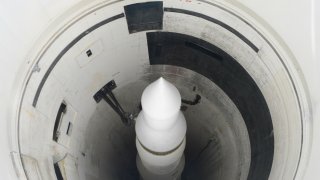Nuclear Arms Control Is For Realists
The world is on the brink of a new arms race.
In 2023, Moscow suspended the New Strategic Arms Reduction Treaty (New START), withdrew from the Conventional Armed Forces in Europe Treaty (CFE), de-ratified the Comprehensive Nuclear Test Ban Treaty (CTBT), linked the resumption of arms control with the United States to a change in U.S.-Russia policy, at least implicitly threatened the use of nuclear weapons and announced the transfer of non-strategic nuclear weapons to Belarus, putting the world on the brink of another Cold War. In addition, the U.S. Congressional Commission on Strategic Posture recommended additional nuclear capabilities to counter a projected increase in Chinese nuclear warheads from 410 today to over 1,500 by 2035. The preparatory meeting of the Nuclear Non-Proliferation Treaty (NPT) Review Conference in August 2023 also ended without a joint factual summary.
The reasons range from a changed geopolitical climate, the rapid expansion of China's nuclear arsenal, and technological innovations, such as long-range conventional weapons, to domestic political polarization in the United States. Under these conditions, which include an increased interest in nuclear deterrence in Europe, the Middle East, and Asia, the first goal of arms control must be to minimize the risk of unintended military escalation, especially between nuclear powers. It should build on positive developments, such as establishing a communication channel between the Russian and U.S. defense ministries in March 2022 and the resumption of U.S.-Chinese military communication in December 2023, preceded by discussions on the dangers of artificial intelligence in nuclear decision-making systems.
The following measures are therefore advisable: restraint in maneuvers, troop movements, and deployment in the NATO-Russia contact zone; steps to prevent an arms race with new INF missiles in Europe; the reaffirmation of the nuclear taboo at the highest political level; the preservation and use of civil society channels for dialogue to capture the drivers behind nuclear build-ups, nuclear rhetoric, and changes in nuclear doctrine; and backward learning from Cold War risk-reduction measures.
The NATO-Russia Council is currently unavailable as a risk reduction format as it is suspended for the foreseeable future. The OSCE, on the other hand, is paralyzed but can be utilized in the future to provide information on defensive positions and military doctrines. It also makes sense to discuss nuclear risks in the P5 process of the five permanent members of the UN Security Council, which China will chair in August 2024. Finally, non-nuclear-weapon states that adopt a more geopolitically neutral stance could exert pressure on nuclear-weapon states to fulfill their disarmament obligations under the NPT.
Even if these steps do not lead to arms control agreements, they can prepare the ground for future progress, complementing other agreements, such as a ceasefire in Ukraine. In the meantime, more traditional calls for a return to full implementation of New START or discussion of possible successor or alternative agreements should continue. However, more is needed. The risks of the use of nuclear weapons and for the Zaporizhzhia nuclear power plant in the Ukraine War have not been eliminated, nor have the dangers of unintended military escalation in East Asia. The United States and Russia are also finding it increasingly challenging to verify the number of warheads on each other's nuclear missiles because the inspections provided for in the New Start Treaty are not currently taking place.
To make matters worse, there is a growing chorus of voices in Russia, as well as in the United States, China, and Europe, calling for higher risks to be taken to increase chances of asserting their interests. The often-unspoken premise is that there is a high degree of escalation and risk control when push comes to shove. This tendency to play vabanque is further encouraged by an attention economy that rewards those who have traded academicism for greater visibility, those who are suitable for a headline but not for sound analysis and policy advice.
For the foreseeable future, the space for arms control will be determined by the requirements of defense and deterrence. This is not unusual when the global balance of power is being rebalanced. For the time being, Moscow is opposed to compartmentalizing nuclear strategic issues because it sees Ukraine's potential Western course as a strategic threat. According to Moscow's view, the West must remove itself from Ukraine, just as the Soviets removed their nuclear missiles from Cuba. This makes understanding tricky as long as the war is still ongoing.
To be effective, arms control advocates must accept the current situation. They can do so with confidence because it is ultimately better suited to managing great power rivalry than approaches that allow no compromise and rely on the other side constantly blinking first. In a nuclear world, absolute thinking is irresponsible, intellectually dull, and unsuitable for statecraft. Arms control was never for friends. It has been and is for realists. And that is as it should be.
Dr. Tobias Fella is the project head in the Berlin office of the Institute for Peace Research and Security Policy at the University of Hamburg (IFSH). His research focuses on the possibilities of arms control in an age of deterrence and great power rivalry. Follow him on X @tobiaspfella.
Image: Shutterstock.com.

